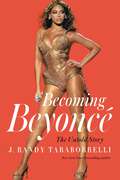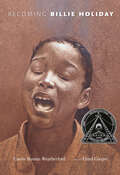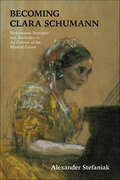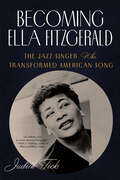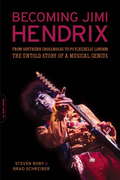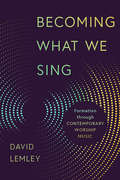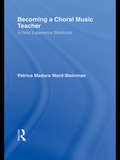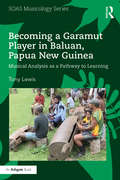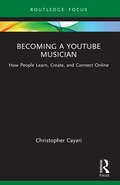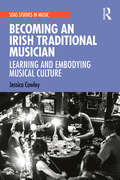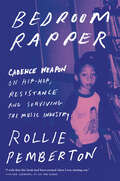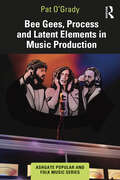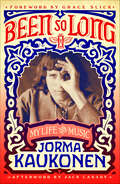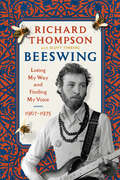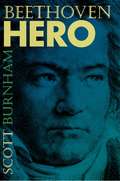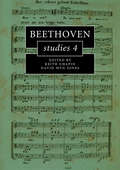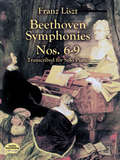- Table View
- List View
Becoming Beyoncé: The Untold Story
by J. Randy TaraborrelliA Billboard Must-Read Fall 2015 Music Book The first comprehensive biography ever published about America's favorite living pop icon, Beyoncé, from New York Times bestselling biographer J. Randy Taraborrelli. <P><P>Beyoncé Knowles is a woman who began her career at the age of eight performing in pageant shows and talent contests, honing her craft through her teenage years until, at the age of 16, she had her first number one record with Destiny's Child. That hit-making trio launched Beyoncé's successful solo career, catapulting her, as of 2014, to #1 on Forbes annual list of most wealthy celebrities--the same year she made the cover of Time. <P><P>BECOMING BEYONCÉ is not only the story of struggle, sacrifice, and what it takes to make it in the cut-throat record industry, it's the story of the great rewards of such success and the devastating toll it often takes on the human spirit.
Becoming Billie Holiday
by Carole Boston Weatherford Floyd CooperBefore the legend of Billie Holiday, there was a girl named Eleanora. In 1915, Sadie Fagan gave birth to a daughter she named Eleanora. The world, however, would know her as Billie Holiday, possibly the greatest jazz singer of all time. <p><p>Eleanora's journey into legend took her through pain, poverty, and run-ins with the law. By the time she was fifteen, she knew she possessed something that could possibly change her life--a voice. Eleanora could sing. <p><p>Her remarkable voice led her to a place in the spotlight with some of the era's hottest big bands. Billie Holiday sang as if she had lived each lyric, and in many ways she had. <p><p>Through a sequence of raw and poignant poems, award-winning poet Carole Boston Weatherford chronicles Eleanora Fagan's metamorphosis into Billie Holiday. The author examines the singer's young life, her fight for survival, and the dream she pursued with passion in this Coretta Scott King Author Honor winner. With stunning art by Floyd Cooper, this book provides a revealing look at a cultural icon.
Becoming Clara Schumann: Performance Strategies and Aesthetics in the Culture of the Musical Canon
by Alexander StefaniakWell before she married Robert Schumann, Clara Schumann was already an internationally renowned pianist, and she concertized extensively for several decades after her husband's death. Despite being tied professionally to Robert, Clara forged her own career and played an important role in forming what we now recognize as the culture of classical music.Becoming Clara Schumann guides readers through her entire career, including performance, composition, edits to her husband's music, and teaching. Alexander Stefaniak brings together the full run of Schumann's concert programs, detailed accounts of her performances and reception, and other previously unexplored primary source material to illuminate how she positioned herself within larger currents in concert life and musical aesthetics. He reveals that she was an accomplished strategist, having played roughly 1,300 concerts across western and central Europe over the course of her six-decade career, and she shaped the canonization of her husband's music. Extraordinary for her time, Schumann earned success and prestige by crafting her own playing style, selecting and composing her own concerts, and acting as her own manager.By highlighting Schumann's navigation of her musical culture's gendered boundaries, Becoming Clara Schumann details how she cultivated her public image in order to win over audiences and embody some of her field's most ambitious aspirations for musical performance.
Becoming Ella Fitzgerald: The Jazz Singer Who Transformed American Song
by Judith TickAn NPR “Books We Love” Pick of the Year A Kirkus Best Nonfiction Book of the Year “[A] radiant, rich, no-stone-unturned biography.”—Paula J. Giddings, author of When and Where I Enter A landmark biography that reclaims Ella Fitzgerald as a major American artist and modernist innovator. Ella Fitzgerald (1917–1996) possessed one of the twentieth century’s most astonishing voices. In this first major biography since Fitzgerald’s death, historian Judith Tick offers a sublime portrait of this ambitious risk-taker whose exceptional musical spontaneity made her a transformational artist. Becoming Ella Fitzgerald clears up long-enduring mysteries. Archival research and in-depth family interviews shed new light on the singer’s difficult childhood in Yonkers, New York, the tragic death of her mother, and the year she spent in a girls’ reformatory school—where she sang in its renowned choir and dreamed of being a dancer. Rarely seen profiles from the Black press offer precious glimpses of Fitzgerald’s tense experiences of racial discrimination and her struggles with constricting models of Black and white femininity at midcentury. Tick’s compelling narrative depicts Fitzgerald’s complicated career in fresh and original detail, upending the traditional view that segregates vocal jazz from the genre’s mainstream. As she navigated the shifting tides between jazz and pop, she used her originality to pioneer modernist vocal jazz. Interpreting long-lost setlists, reviews from both white and Black newspapers, and newly released footage and recordings, the book explores how Ella’s transcendence as an improvisor produced onstage performances every bit as significant as her historic recorded oeuvre. From the singer’s first performance at the Apollo Theatre’s famous “Amateur Night” to the Savoy Ballroom, where Fitzgerald broke through with Chick Webb’s big band in the 1930s, Tick evokes the jazz world in riveting detail. She describes how Ella helped shape the bebop movement in the 1940s, as she joined Dizzy Gillespie and her then-husband, Ray Brown, in the world-touring Jazz at the Philharmonic, one of the first moments of high-culture acceptance for the disreputable art form. Breaking ground as a female bandleader, Fitzgerald refuted expectations of musical Blackness, deftly balancing artistic ambition and market expectations. Her legendary exploration of the Great American Songbook in the 1950s fused a Black vocal aesthetic and jazz improvisation to revolutionize the popular repertoire. This hybridity often confounded critics, yet throughout the 1970s and 1980s, Ella reached audiences around the world, electrifying concert halls, and sold millions of records. A masterful biography, Becoming Ella Fitzgerald describes a powerful woman who set a standard for American excellence nearly unmatched in the twentieth century.
Becoming Heinrich Schenker
by Robert P. MorganMuch controversy surrounds Schenker's mature theory and its attempt to explain musical pitch motion. Becoming Heinrich Schenker brings a new perspective to Schenker's theoretical work, showing that ideas characteristic of his mature theory, although in many respects fundamentally different, developed logically out of his earlier ideas. Robert Morgan provides an introduction to Schenker's mature theory and traces its development through all of his major publications, considering each in detail and with numerous music examples. Morgan also explores the relationship between Schenker's theory and his troubled ideology, which crucially influenced the evolution of his ideas and was heavily dependent upon both the empirical and idealist strains of contemporary German philosophical thought. Relying where possible on quotations from Schenker's own words, this book offers a balanced approach to his theory and a unique overview of this central music figure, generally considered to be the most prominent music theorist of the twentieth century.
Becoming Jimi Hendrix: From Southern Crossroads to Psychedelic London, the Untold Story of a Musical Genius
by Steven Roby Brad SchreiberThe first in-depth biography of the formative years of the greatest electric guitarist of all time, with 25 rare photos, complete sessionography, and tour itinerary
Becoming What We Sing: Formation through Contemporary Worship Music (Calvin Institute of Christian Worship Liturgical Studies)
by David LemleyContemporary worship music is ubiquitous in many Protestant Christian communities today. Rather than debating or decrying this post–worship-wars reality, David Lemley accepts it as a premise and examines what it means for us to be singing along with songs that aren&’t so different from the pop genre. How do we cope with the consumerism embedded in the mentality that catchy is good? How do we stay committed to subverting cultural norms, as Christians are called to do, when our music is modeled after those cultural norms? How do we ensure that the way we participate in the liturgy of contemporary worship music rehearses a cruciform identity? Becoming What We Sing draws on cultural criticism, ethnomusicology, and liturgical and sacramental theology to process the deluge of the contemporary in today&’s worship music. Lemley probes the thought of historical figures, such as Augustine, Hildegard of Bingen, Martin Luther, and the Wesleys, while also staying situated in the current moment by engaging with cultural philosophers such as James K. A. Smith and popular artists such as U2. The result is a thorough assessment of contemporary worship music&’s cultural economy that will guide readers toward greater consciousness of who we are becoming as we sing &“our way into selves, societies, and cosmic perspectives.&”
Becoming a Choral Music Teacher: A Field Experience Workbook
by Patrice Madura Ward-SteinmanThis textbook prepares Music Education and Choral Conducting majors to be effective middle school and high school choral music teachers. It fully integrates the choral field experience for hands-on learning and reflection and allows the student to observe and teach the book’s principles. It covers the essentials of vocal development, auditions, literature, rehearsals, classroom management, and practical matters.
Becoming a Choral Music Teacher: A Field Experience Workbook
by Patrice Madura Ward-SteinmanBecoming a Choral Music Teacher: A Field Experience Workbook, Second Edition is a choral methods textbook that prepares students in Music Education to become middle school and high school choral music teachers. It emphasizes important musical skills, vocal pedagogy and repertoire suitable for secondary school choirs in order to provide future teachers with the critical experiences to be effective. Focusing equally on rehearsal strategies, auditions and classroom management, the book is also a "workbook" that requires the students’ active learning through participation in fieldwork. Students learn in a sequential and practical manner, beginning with the study of the middle school voice and progressing to the high school voice, through practice of theory with adolescents, followed by class reflection on common problems and solutions, and then continued practice. NEW to this Edition Updated references to NAfME, and new national and state standards and licensing rules More on the needs of Special Learners in the choral classroom Latest resources on classroom management theories and practice Expanded vocal warm-ups that incorporate body movement and aural skills training More on gender issues (including LGBT awareness), sociological impact and meanings of choral singing, and emerging knowledge of multicultural choral music Becoming a Choral Music Teacher: A Field Experience Workbook, Second Edition fully integrates the choral field experience for hands-on learning and reflection and allows the student to observe and teach the book’s principles.
Becoming a Garamut Player in Baluan, Papua New Guinea: Musical Analysis as a Pathway to Learning (SOAS Musicology Series)
by Tony LewisThe garamut is a log idiophone that is found in many of the coastal and island areas of Papua New Guinea. The instrument’s primary use is as a speech surrogate and in some regions the garamut is also used in large ensembles to play complex music for dancing. In Baluan Island, within the Manus Province, this style of garamut playing is comparatively highly developed. This book follows the author’s processes and methods in learning to play the music of the garamut, to the level at which he became accepted as a garamut player by the people of Baluan. Lewis argues that analysis is essential in learning to play the rapid tempi and complex rhythms of Baluan garamut music, in a cultural context where there is no formal teaching process for the music. The transcription and analysis of the Baluan garamut repertoire is the centrepiece of this study, reflecting the cognitive structures of the learning process, and revealing the inner workings of the music’s complexity as well as a striking beauty of form and structure. The book concludes with reflections on the process of a ‘cultural outsider’ becoming a garamut player in Baluan and on the role of musical analysis in that process, on the ethnomusicologist’s role in transmission of the music, and on the nature of continuity and change in a musical society such as Baluan.
Becoming a YouTube Musician: How People Learn, Create, and Connect Online (Routledge New Directions in Music Education Series)
by Christopher CayariAs the most-visited social media site on the internet, the video-sharing platform YouTube has become a highly influential space for musicmaking and learning. Becoming a YouTube Musician: How People Learn, Create, and Connect Online explores how YouTube creators and viewers are using digital video to create and consume music, develop online communities, and engage in formal, informal, and experimental music learning.Drawing on 26 case studies, the author challenges music educators to incorporate the learning, creative, and social practices of online musicians into their classrooms by helping students learn to participate in an online music system like YouTube. While this book serves as an in-depth analysis of a specific platform, the concepts within are more universal. Becoming a YouTube Musician encourages readers to consider how technology, media, and the internet can be used to innovate teaching by incorporating popular practices that exist on social media. The author shows educators how to apply lessons from the practices of YouTube musicians in their classrooms, facilitating student creativity and engagement in new ways.
Becoming an Irish Traditional Musician: Learning and Embodying Musical Culture (SOAS Studies in Music)
by Jessica CawleyCoupling the narratives of twenty-two Irish traditional musicians alongside intensive field research, Becoming an Irish Traditional Musician explores the rich and diverse ways traditional musicians hone their craft. It details the educational benefits and challenges associated with each learning practice, outlining the motivations and obstacles learners experience during musical development. By exploring learning from the point of view of the learners themselves, the author provides new insights into modern Irish traditional music culture and how people begin to embody a musical tradition. This book charts the journey of becoming an Irish traditional musician and explores how musicality is learned, developed, and embodied.
Bedroom Rapper: Cadence Weapon on Hip-Hop, Resistance and Surviving the Music Industry
by Rollie PembertonBedroom Rapper is a book for obsessive music fans who are looking for the definitive take on what&’s happened in the last two decades of hip hop, from Cadence Weapon, aka Rollie Pemberton: Pitchfork critic, award-winning musician, producer, DJ, and poet laureate.Tracing his roots from recording beats in his mom's attic in Edmonton to performing with some of the most recognizable names in rap and electronic music—De La Soul, Public Enemy, Mos Def, Questlove, Diplo, and more—Polaris Prize winner Rollie Pemberton, a.k.a Cadence Weapon, captures the joy in finding yourself, and how a sense of place and purpose entwines inextricably with a music scene. From competitive basement family karaoke to touring Europe, from fights with an exploitative label to finding his creative voice, from protesting against gentrification to using his music to centre political change, Rollie charts his own development alongside a shifting musical landscape. As Rollie finds his feet, the bottom falls out of the industry, and he captures the way so many artists were able to make a nimble name for themselves while labels floundered. Bedroom Rapper also offers us a wide-ranging and crucial history of hip-hop. With an international perspective that's often missing from rap music journalism, he integrates the gestation of American hip hop with UK grime and niche scenes from the Canadian prairies, bringing his obsessive knowledge of hip-hop to bear on his subject. Rollie takes us into New York in the &’70s, Edmonton in the &’90s, the legendary Montreal DIY loft scene of the 2000s, and traces the ups and downs of trusting your gut and following your passion, obsessively. With a foreword by Gabriel Szatan, music fans and creators alike will relate to the dedication to craft, obsessive passion for what came before, and desire to shift the future that is embodied in every creative project Rollie takes on.
Bedsit Disco Queen: How I Grew Up and Tried to be a Pop Star
by Tracey ThornI was only sixteen when I bought an electric guitar and joined a band. A year later, I formed an all-girl band called the Marine Girls and played gigs, and signed to an indie label, and started releasing records.Then, for eighteen years, between 1982 and 2000, I was one half of the group Everything But the Girl. In that time, we released nine albums and sold nine million records. We went on countless tours, had hit singles and flop singles, were reviewed and interviewed to within an inch of our lives. I've been in the charts, out of them, back in. I've seen myself described as an indie darling, a middle-of-the-road nobody and a disco diva. I haven't always fitted in, you see, and that's made me face up to the realities of a pop career - there are thrills and wonders to be experienced, yes, but also moments of doubt, mistakes, violent lifestyle changes from luxury to squalor and back again, sometimes within minutes.
Bedsit Disco Queen: How I grew up and tried to be a pop star
by Tracey ThornI was only sixteen when I bought an electric guitar and joined a band. A year later, I formed an all-girl band called the Marine Girls and played gigs, and signed to an indie label, and started releasing records.Then, for eighteen years, between 1982 and 2000, I was one half of the group Everything But the Girl. In that time, we released nine albums and sold nine million records. We went on countless tours, had hit singles and flop singles, were reviewed and interviewed to within an inch of our lives. I've been in the charts, out of them, back in. I've seen myself described as an indie darling, a middle-of-the-road nobody and a disco diva. I haven't always fitted in, you see, and that's made me face up to the realities of a pop career - there are thrills and wonders to be experienced, yes, but also moments of doubt, mistakes, violent lifestyle changes from luxury to squalor and back again, sometimes within minutes.
Bedsit Disco Queen: How I grew up and tried to be a pop star
by Tracey ThornI was only sixteen when I bought an electric guitar and joined a band. A year later, I formed an all-girl band called the Marine Girls and played gigs, and signed to an indie label, and started releasing records.Then, for eighteen years, between 1982 and 2000, I was one half of the group Everything But the Girl. In that time, we released nine albums and sold nine million records. We went on countless tours, had hit singles and flop singles, were reviewed and interviewed to within an inch of our lives. I've been in the charts, out of them, back in. I've seen myself described as an indie darling, a middle-of-the-road nobody and a disco diva. I haven't always fitted in, you see, and that's made me face up to the realities of a pop career - there are thrills and wonders to be experienced, yes, but also moments of doubt, mistakes, violent lifestyle changes from luxury to squalor and back again, sometimes within minutes.
Bedtime for Baby Shark: Doo Doo Doo Doo Doo Doo (Baby Shark)
by John John BajetSing and dance along with Baby Shark as he gets ready for bed in this playful song and story -- the follow-up to the bestselling picture book!How does Baby Shark get ready for bed?Brush your teeth! Doo doo doo doo doo doo!Take a bath! Doo doo doo doo doo doo!Read a book! Doo doo doo doo doo doo!Off to sleep!Sing, dance, and read along to this brand-new bedtime song, featuring Baby Shark, Mama Shark, Daddy Shark, and more underwater friends. Kids and caregivers alike will delight in this silly illustrated story of a shark family's bedtime routine, full of funny, eye-popping illustrations and a catchy tune you won't be able to stop singing. Also features helpful picture guides so readers can dance along, act out the hand and foot movements, and develop their fine motor skills. By the end of the story, little ones will be laughing, singing, and dancing their way off to sleep with this charming and catchy read-aloud!Are you ready to help Baby Shark get ready for bedtime?
Bedtime for Baby Shark: Doo Doo Doo Doo Doo Doo / Duu Duu Duu Duu Duu Duu (Baby Shark)
by John John BajetSing and dance along with Baby Shark as he gets ready for bed in this playful song and story -- the follow-up to the bestselling picture book!Canta, baila y lee esta nueva cancion para la hora de dormir que presenta a Bebe Tiburon, Mama Tiburon, Papa Tiburon y otros amigos subacuaticos. Los ninos y sus cuidadores se divertiran por igual con esta simpatica historia que narra la rutina de una familia tiburon a la hora de dormir, con llamativas y divertidas ilustraciones y una melodia pegadiza que no podran dejar de cantar.¿Estas listo para ayudar a Bebe Tiburon a prepararse para dormir?Sing, dance, and read along to this brand-new bedtime song, featuring Baby Shark, Mama Shark, Daddy Shark, and more underwater friends. Kids and caregivers alike will delight in this silly illustrated story of a shark family's bedtime routine, full of funny, eye-popping illustrations and a catchy tune you won't be able to stop singing.Are you ready to help Baby Shark get ready for bedtime?
Bee Gees, Process and Latent Elements in Music Production (Ashgate Popular and Folk Music Series)
by Pat O’GradyThis book examines the creative process of the Bee Gees and the latent elements that shaped their sound. From their formative Australian work to the highs of their disco years and the scores of songs they wrote and produced for other artists, the Bee Gees’ catalogue is vast and varied. It is also distinctive. Songs feature their signature falsetto vocals, close three-part harmony, and knack for pop songwriting. This book takes a unique approach to the musicology of music production. It analyzes processual accounts and demo recordings to uncover what are defined as the latent elements of music production, such as instruments, lyrics, meanings, space, sounds, and recording techniques that are crucial in shaping the completed recordings but are absent from what we hear. It is a must-read book for music production academics and students, as well as anyone interested in the Bee Gees’ creative process.
Been So Long: My Life and Music
by Jorma Kaukonen"A modern parable." —from the foreword by Grace Slick“Jorma Kaukonen is a force in American music, equally adept at fingerpicked acoustic folk and blues as he is at wailing on an electric.” – Acoustic Guitar“Jorma Kaukonen lit a fuse and transformed his electric guitar into a firework.” – Live For Live MusicIncludes a CD of live music as a companion to the book!From the man who made a name for himself as a founding member and lead guitarist of Jefferson Airplane comes a memoir that offers a rare glimpse into the heart and soul of a musical genius—and a vivid journey through the psychedelic era in America. “Music is the reward for being alive,” writes Jorma Kaukonen in this candid and emotional account of his life and work. “It stirs memory in a singular way that is unmatched.” In a career that has already spanned a half century—one that has earned him induction into the Rock & Roll Hall of Fame and a Grammy Lifetime Achievement Award, among other honors—Jorma is best known for his legendary bands Jefferson Airplane and the still-touring Hot Tuna. But before he won worldwide recognition he was just a young man with a passion and a dream.Been So Long is the story of how Jorma found his place in the world of music and beyond. The grandson of Finnish and Russian-Jewish immigrants whose formative years were spent abroad with his American-born diplomat father, Jorma channeled his life experiences—from his coming-of-age in Pakistan and the Philippines to his early gigs with Jack Casady in D.C. to his jam sessions in San Francisco with Jerry Garcia, Janis Joplin, Bob Dylan, and other contemporaries—into his art in unique and revelatory ways. Been So Long charts not only Jorma’s association with the bands that made him famous but goes into never-before-told details about his addiction and recovery, his troubled first marriage and still-thriving second, and more. Interspersed with diary entries, personal correspondence, and song lyrics, this memoir is as unforgettable and inspiring as Jorma’s music itself.
Beeswing: Losing My Way and Finding My Voice 1967-1975
by Richard ThompsonAn intimate look at the early years of one of the world&’s most significant and influential guitarists and songwriters. In this moving and immersive memoir, Richard Thompson, international and longtime beloved music legend, recreates the spirit of the 1960s, where he found, and then lost, and then found his way again. Known for his brilliant songwriting, his extraordinary guitar playing, and his haunting voice, Thompson is considered one of the top twenty guitarists of all time, in the songwriting pantheon alongside Bob Dylan, Paul Simon, and Randy Newman. Now, in his long-awaited memoir, the British folk musician takes us back to the late 1960s, a period of great change and creativity—both for him and for the world at large. Thompson packed more than a lifetime of experiences into his late teens and twenties. During the pivotal years of 1967 to 1975, just as he was discovering his passion for music, he formed the band Fairport Convention with some schoolmates and helped establish the genre of British folk rock. That led to a heady period of songwriting and massive tours, where Thompson was on the road both in the UK and the US, and where he crossed paths with the likes of Led Zeppelin, Pink Floyd, and Jimi Hendrix. But those eight years were also marked by change, upheaval, and tragedy. Then, at the height of the band&’s popularity, Thompson left to form a duo act with his wife Linda. And as he writes revealingly here, his discovery and ultimate embrace of Sufism dramatically reshaped his approach to music—and of course everything else. An honest, moving, and compelling memoir, Beeswing vividly captures the life of a remarkable artist during a period of creative intensity in a world on the cusp of change.
Beethoven
by Maynard SolomonBiography of the composer with selective bibliography and an index of his compositions
Beethoven Hero
by Scott BurnhamBringing together reception history, music analysis and criticism, the history of music theory, and the philosophy of music, Beethoven Hero explores the nature and persistence of Beethoven's heroic style. What have we come to value in this music, asks Scott Burnham, and why do generations of critics and analysts hear it in much the same way? Specifically, what is it that fosters the intensity of listener engagement with the heroic style, the often overwhelming sense of identification with its musical process? Starting with the story of heroic quest heard time and again in the first movement of the Eroica Symphony, Burnham suggests that Beethoven's music matters profoundly to its listeners because it projects an empowering sense of self, destiny, and freedom, while modeling ironic self-consciousness. In addition to thus identifying Beethoven's music as an overarching expression of values central to the age of Goethe and Hegel, the author describes and then critiques the process by which the musical values of the heroic style quickly became the controlling model of compositional logic in Western music criticism and analysis. Apart from its importance for students of Beethoven, this book will appeal to those interested in canon formation in the arts and in music as a cultural, ethical, and emotional force--and to anyone concerned with what we want from music and what music does for us.
Beethoven Studies 4 (Cambridge Composer Studies)
by David Wyn Jones Keith ChapinDid you know that Beethoven contemplated, however fleetingly, writing more than forty symphonies and that for the Missa solemnis he sought stimulus from a Latin-German dictionary? And what about the underappreciated sociable side of Beethoven's music to set alongside the familiar one of the heroic? Beethoven Studies 4 is a collection of ten chapters that approach the composer and his music from an appealing range of critical standpoints, aesthetic, analytical, biographical, historical and performance. Alongside essays that offer new information on Beethoven's compositional practice and broaden understanding of the music's contemporary and posthumous appeal, there are essays on his interaction with specific environments, Bonn and post-Napoleonic Austria, and vocal and piano performance practice. The volume will appeal to cultural historians and practitioners as well as Beethoven enthusiasts.
Beethoven Symphonies Nos. 6-9 Transcribed for Solo Piano
by Franz LisztThe greatest piano virtuoso of the 19th century, Franz Liszt possessed an astonishing ability to recreate orchestral fabric at the keyboard, enabling pianists to reproduce the texture and grandeur of symphonic works. This volume is the second of Dover's two-part set of Liszt’s piano transcriptions of Beethoven's nine symphonies, reproduced from the edition authorized by Liszt himself. Its contents include Symphony No. 6 in F major, Op. 68, "Pastorale"; Symphony No. 7 in A major, Op. 92; Symphony No. 8 in F major, Op. 93; and Symphony No. 9 in D minor, Op. 125, "Choral."The collection also contains engrossing pieces of background information, including a facsimile of Liszt's handwritten French preface to his Beethoven transcriptions (along with its English translation), as well as an introduction by Dr. Alan Walker, author of the definitive three volume Liszt biography.A memorable tribute from one musical genius to another, these beautiful transcriptions will delight pianists and music lovers alike.
